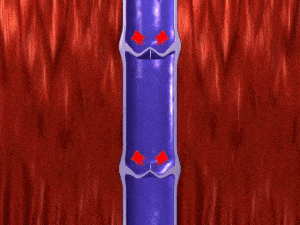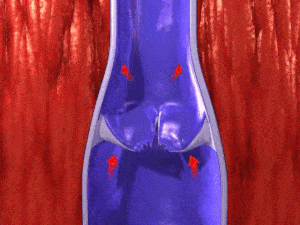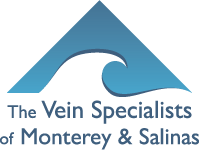Causes of Spider Veins and How to Get Rid of Them
Spider veins are smaller purple and red veins which you cannot usually feel on the skin. Spider veins look much like varicose veins under enough magnification, but spider veins are less likely to cause symptoms than varicose veins.
Spider veins are a result of chronic vein disease. Chronic vein disease is caused by failure of vein valves to keep the blood in your legs flowing correctly towards your heart when you are sitting or standing. Instead, the blood flows back down the leg, pressurizing the venous system below, and causing high pressure in the veins (venous hypertension, not arterial hypertension or high blood pressure).

Valve

Valve Failure
Varicose and spider vein symptoms are usually worse with standing or sitting because the venous valves do not prevent flow back down the leg. These symptoms usually improve with leg elevation because the venous blood flows correctly even though the venous valves are not working correctly.
Twenty-five percent of adults have varicose veins and/or chronic vein disease. Not all patients have risk factors to have the disease, but the common risk factors include:
- Genetics (family history)
- Aging: the risk to have varicose veins increases each decade of life
- Standing occupation
- Number of pregnancies: the greater the number, the higher the risk
- Being overweight increases the risk for leg swelling and calf skin changes
The natural history of chronic vein disease without treatment is to worsen gradually over time. Patients develop more varicose veins, more pain and discomfort, more skin changes, and more areas of abnormal flow on ultrasound.
Conservative Measures for Chronic Vein Disease
The first step in managing chronic vein disease is performing conservative measures:
- Compression stockings improve vein symptoms for most vein patients. We use stockings after every vein procedure for 1-2 weeks. Most insurance companies require a documented trial of conservative measures under my supervision before they will approve any vein treatment. You can use compression stockings whenever you want, but they are usually most effective on days when you are sitting or standing a lot.
- Leg elevation usually helps reduce vein symptoms. If you elevate your legs above your heart, the blood will flow correctly even if the venous valves have failed.
- Exercise that is good for your general health is good for your vein health also. Walking is good exercise to help with chronic vein disease since it strengthens the calf muscle and improves ankle range of motion, which helps pump more leg blood back to the heart.
- You can take over the counter pain medicines to help with pain. As long as you tolerate it, ibuprofen or naproxen tend to work well for vein symptoms. Make sure you stick to recommended doses. It is generally best to take these medicines with food, because they can upset your stomach.
How to Get Rid of Spider Veins
In determining a spider vein treatment, it is important to visit a comprehensive vein specialist who can assess the extent of your vein disease. The most common spider vein treatments are sclerotherapy and to a lesser extent, surface (non-surgical) laser treatment. Sclerotherapy involves the injection (directly into the spider vein) of a chemical solution that will close the offending vein, causing it to disintegrate. If underlying venous disease is present, other vein treatment methods may need to be employed.
Sclerotherapy, or chemical ablation, is performed to close the visible varicose veins and other abnormal veins not closeable with heat ablation. A sclerotherapy session takes 30 minutes and no anesthesia is needed. During sclerotherapy, we usually inject many veins. We often cannot treat every abnormal vein because we can only safely give you a limited amount of the medicine (the dose) in one day. It usually takes three sessions, or even more in occasional cases, to get the best results. There is usually little or no pain or discomfort after sclerotherapy.
At Vein Specialists of Monterey – with clinics in Monterey and Salinas, California, Dr. Eric Mowatt-Larssen uses the latest technological advances in treating vein disorders in the most minimally invasive way possible. At our vein clinics in Monterey and Salinas, we use sclerotherapy – the injection of medicine into the vein, to close the spider veins. Dr. Larssen has performed tens of thousands of sclerotherapies over the ten years that he has been focused solely on vein medicine. Skill, experience and technique are hugely important for effectiveness in this field of medicine. Sclerotherapy is considered the gold standard for the treatment of spider veins. If you are in the Monterey, Salinas, Watsonville or King City area seek treatment of spider veins with an experienced, certified professional vein doctor. Expect your treatment to be:
- Easy
- Cause Minimal Discomfort
- Have a Fast Recovery
